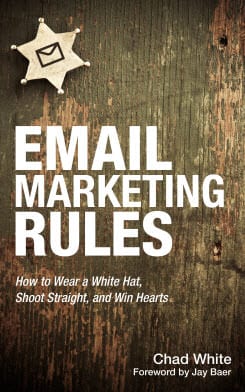Retail email expert Chad White talks about email frequency, list acquisition, mobile challenges, and more...
Retail email has seen its stock rise significantly in recent times. And recognition of its value as a significant source of both online and offline sales has reignited debates on permission requirements, optimum frequencies and just what constitutes a best practice.
 There are few people in this world who know more about these kinds of retail email issues than Chad White.
There are few people in this world who know more about these kinds of retail email issues than Chad White.
Currently Principal of Marketing Research at ExactTarget, Chad recently authored a new book: "Email Marketing Rules: How to Wear a White Hat, Shoot Straight, and Win Hearts".
Given his expertise, I decided to get his opinion on some of the top practical issues facing retail email marketers today...
The first issue concerns a bit of a backlash among the email marketing community against "best practices", with some suggesting they promote inflexibility, even mediocrity.
Smart Insights: What's your view on the "best practices are dead" debate?
Chad White: Saying best practices are dead is like saying there are no industry learnings, that every brand has to reinvent the wheel every time they do anything with their email program. That's just silly.
While our industry is constantly evolving, there are very clearly rules worth following-or at least worth heeding. In my book I discuss 108 of them, so there's no shortage of best practices.
I think many people misunderstand or misidentify best practices. Very few best practices are a tick-the-box experience. Most allow for a wide range of executions, giving brands the opportunity to differentiate themselves through brand expression and technological savvy. So even if two brands are following the same best practice, their execution is likely to be very different.
Smart Insights: Your book is very oriented to strong permission practices, and list acquisition is a prominent topic. What are the top two or three mistakes - practical or conceptual - retailers are making in this context?
Chad White: Yes, I take a very "white hat" approach to permission. The ISPs and anti-spam groups like Spamhaus are clearly tightening the reins on marketers and I wanted to make it clear to readers that when they do an e-append or buy a list, for instance, they are putting their program at risk.
This message is particularly critical for SMB marketers, who are generally much slower to identify and fix deliverability problems caused by poor permission practices.
 "All subscribers are not created equal" - Chad White
"All subscribers are not created equal" - Chad White
One of the reasons that some marketers engage in these risky behaviors is because they don't measure the value of a subscriber by acquisition source.
All subscribers are not created equal. A subscriber you acquire on your website is more valuable than a subscriber who signs up on your Facebook page, which is in turn more valuable than a subscriber acquired through co-registration, and so on.
Knowing this information can help you make decisions about which acquisition sources to use, which to spend time optimizing, and which not to bother with.
Another concept that's becoming more critical to understand and accept is that permission expires. ISPs are penalizing marketers pretty heavily now for endlessly emailing addresses that aren't registering any opens or clicks.
So while marketers are loath to stop mailing people who opted in, at a certain point you're jeopardizing your ability to reach your active subscribers by continuing to mail folks who long ago stopped interacting with your emails.
Smart Insights: In particular, you advise against sharing email addresses with sister brands or companies. This is a great temptation for those running multiple lists, so how can or should you exploit one list to help build another?
Chad White: Thankfully most brands resist this temptation.
There are many ways to cross-promote sister brands without violating permission. For instance, Gap uses a universal email opt-in page that allows a consumer to sign up for emails from multiple brands at the same time:
Other brands like Lane Bryant include the logos of their sister brands at the bottom of their emails to raise awareness:
And then there are brands like Anthropologie that include secondary messages from sister brands in their emails or even occasionally send full, dedicated emails about a sister brand using their usual sender address and name:
Smart Insights: There's also a growing opinion that retailers are not sending enough email, and are focused too much on advanced targeting and personalization and not enough on simply getting more emails into the inbox. Where do you stand on this frequency debate?
Chad White: The ROI of triggered emails and other advanced targeting tactics is multiple times the ROI of a broadcast email-so honestly I don't know of any brand that's "too focused" on this. All kidding aside, I think it's a serious competitive risk not to be investing in advanced targeting and personalization.
The problem with the current debate about whether brands are sending too much or too little email is that it fails to acknowledge that different subscribers should receive different amounts of email depending on their engagement level.
A number of brands have experienced deliverability problems because they send email-and usually a lot of it-to inactive subscribers. At the other end of the spectrum, there are definitely opportunities to send your most engaged subscribers more email. I think triggered and segmented emails are the smartest way to send these subscribers more email in a way that respects their high-value status.
"...different subscribers should receive different amounts of email depending on their engagement level" - Chad White
All that said, despite promotional email volume rising significantly in recent years, consumers have actually become more tolerant of email volumes. But considering how quickly consumer sentiment can change, I think it's unwise to assume that this trend will continue indefinitely.
Smart Insights: The media, vendors, etc. tend to focus on email improvements typically involving investment (in time or money) in new tools, database integration etc. But in your experience of how most retail email is done, what are the two or three quick and easy improvements that retailers can implement without heavy investment?
Chad White: One opportunity for quick wins is to do more A/B testing.
Start with subject line testing, which most ESPs make very easy now, and then mix in some testing of different headlines, images and calls-to-action. Sometimes tests don't reveal anything significant but other times you strike gold. Set up a testing calendar and make sure to periodically retest to validate your learnings.
Another easy place to find improvement is to audit your opt-in and opt-out processes.
Some marketers don't update these regularly so there can be big opportunities to make improvements that increase signups and decrease opt-outs-both of which boost list growth.
Smart Insights: Many retailers are reluctant to invest in extensive and expensive template redesigns for mobile. In the past, you've suggested even small changes can help here. Can you give us some examples of where retailers are adapting to mobile email use without changing everything about their email?
Chad White: This year I've seen a number of brands invest in responsive email design, with many reporting performance improvements of 10% to 20%. But for the most part, brands are implementing simpler "mobile aware" techniques such as increasing their font sizes, using larger touch-friendly buttons, avoiding placing links too close together, moving to a single-column design, and using product grids that are only two or three columns wide. Lowe's emails are a great example of this approach:
Smart Insights: Finally, as a long-time follower of the industry, what's the biggest challenge ahead and how are retailers going to have to change their email perspective to meet it?
Chad White: Mobile has just started to challenge email marketers. That will be an issue for years to come and changing our email designs is just the beginning.
Mobile coupons, mobile payments, location-based messaging-all will have a significant effect on email marketing. The mobile web is only just now entering its awkward adolescence. It's going to get way better, which will boost both online purchases and offline purchases via smartphones. That, plus greater inbox functionality, will be a huge boon to email marketers.


 There are few people in this world who know more about these kinds of retail email issues than Chad White.
There are few people in this world who know more about these kinds of retail email issues than Chad White. "All subscribers are not created equal" - Chad White
"All subscribers are not created equal" - Chad White





